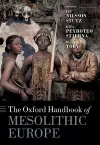
The Oxford Handbook of Mesolithic Europe
3 contributors - Hardback
£190.00
Liv Nilsson Stutz is Professor of Archaeology at Linnaeus University and has a background in archaeology and biological anthropology. She is a specialist in burial archaeology with a particular focus on archeothanatology, ritual practice, ritual theory, and body theory, which she has applied in a reinterpretation of Mesolithic mortuary practices with case studies in Scandinavia, the Eastern Baltic, and Portugal. Her work also engages concepts of hunter gatherer cosmology and ontology. She has published broadly on the archaeology of death, archaeological method and theory, ritual theory, and on issues of research ethics. Rita Peyroteo Stjerna is a Researcher at the Department of Organismal Biology, Upssala University. She is a bioarchaeologist specializing in mortuary archaeology.She is trained in archaeothanatology, ancient DNA, radiocarbon, and stable isotopes. She thrives in interdisciplinary environments and has been working with archaeological human remains in museums in Europe, Africa, and Southeast Asia. She holds a PhD in archaeology from Uppsala University, focusing on the role of mortuary ritual practice in Mesolithic hunter-gatherers, and she has published on Holocene hunter-gatherers in Western Europe integrating multiple disciplines. Her main interests are mortuary archaeology, archaeological science, and ethical issues concerning the biomolecular research of ancient human remains. Mari Tõrv is Associate Professor in Archaeology at the Institute of History and Archaeology, University of Tartu. She is an archaeologist with a multi-disciplinary background in archaeology, human osteology, archaeothanatology, stable isotope studies, and ritual studies. Her research interests are wide, extending from hunter-gatherer mortuary practices and identities to the genetic history of Nordic and Eastern European populations together with life and death ways of early farmers and first Christians. Currently, her work bridges archaeology and chemistry to reconstruct past food ways and explore the research potential of archaeological human remains in general. Her work involves the application of the state-of-the-art methods in stable isotope studies and their combination with other biomolecular analysis to form narratives about past lifestyles.